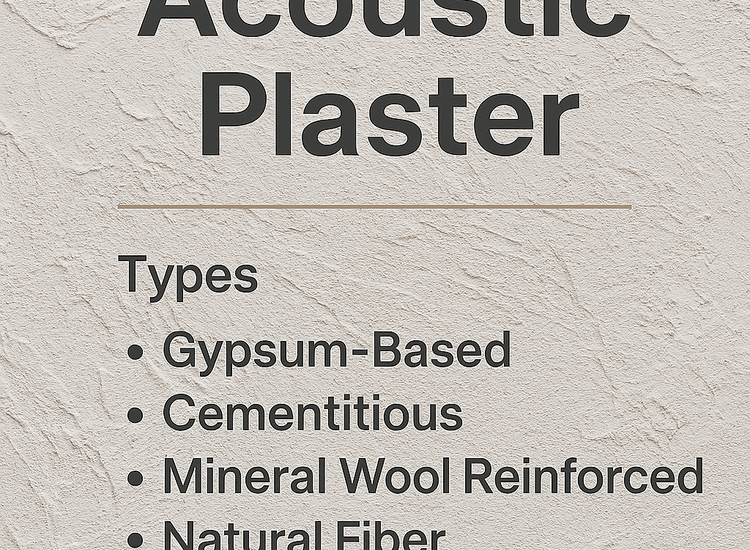Acoustic plaster is a fusion of functionality and aesthetics to tame noise and elevate interior finishes. It’s a seamless solution that transforms walls and ceilings into sound-absorbing surfaces without sacrificing style.
This guide unpacks what acoustic plaster is, explores its key advantages, and dives into the most common types you can specify for residential, commercial, or public spaces.
What Is Acoustic Plaster?
Acoustic plaster is a specialized finishing material formulated to absorb and dampen sound. Unlike standard plaster, it incorporates porous aggregates or fibers that trap and dissipate sound waves. Once applied, it provides a smooth, monolithic surface—no visible panels or perforations—while reducing reverberation and echo.
Benefits of Acoustic Plaster
- Seamless Finish that Appeals the Eyes
- High Sound-Absorption Performance
- Fire Resistance (depending on formulation)
- Durability and Impact Resistance
- Customizable Color and Texture
Types of Acoustic Plaster
Below is a summary table comparing the main acoustic plaster types and their key attributes:
| Type | Composition | NRC Range* | Typical Use |
|---|---|---|---|
| Gypsum-Based | Gypsum binder + mineral fillers | 0.50–0.80 | Offices, school corridors |
| Cementitious | Cement binder + lightweight aggregates | 0.45–0.75 | Industrial, gyms |
| Mineral Wool Reinforced | Plaster mixed with mineral wool fibers | 0.60–0.90 | Auditoriums, recording studios |
| Natural Fiber (Hemp, Cork) | Lime or gypsum base + natural fibers | 0.55–0.85 | Eco-friendly residential |
| Perforated Basecoat | Plaster over perforated board | 0.40–0.70 | Renovations, retrofit jobs |
*Noise Reduction Coefficient (NRC) indicates the fraction of sound absorbed (higher is better).
*Noise Reduction Coefficient (NRC) indicates the fraction of sound absorbed (higher is better).
Gypsum-Based Acoustic Plaster
- Composition: Gypsum binder combined with finely ground mineral aggregates
- Advantages: Rapid setting time, smooth application, excellent finish quality
- Limitations: Slightly lower moisture resistance compared to cementitious options
Cementitious Acoustic Plaster
- Composition: Cementitious binder with lightweight aggregates (e.g., expanded perlite)
- Advantages: Superior durability, moisture tolerance, and impact resistance
- Limitations: Heavier weight; requires sturdy substrates and more labor to apply
Mineral Wool Reinforced Plaster
- Composition: Standard plaster matrix enriched with mineral wool fibers
- Advantages: Highest sound-absorption performance, non-combustible
- Limitations: Premium cost; requires careful mixing and spraying equipment
Natural Fiber Acoustic Plaster
- Composition: Lime or gypsum base blended with hemp, cork, or straw fibers
- Advantages: Renewable, low-VOC, appealing to green-building standards
- Limitations: Variability in fiber quality; may require protective finishes
Perforated Basecoat with Plaster Finish
- Composition: First layer over pre-manufactured perforated gypsum or wood wool board, followed by a topcoat of fine plaster
- Advantages: Ideal for retrofit projects; leverages existing acoustic board solutions
- Limitations: Visible board joints if not meticulously finished
Installation Overview
- Substrate Preparation
Ensure walls or ceilings are dry, clean, and structurally sound. - Basecoat Application
For direct-apply systems, spray or trowel the acoustic plaster to designed thickness (typically 6–12 mm). - Reinforcement (if required)
Embed fiberglass mesh or mineral wool layer for crack control and enhanced absorption. - Finish Coat
Float or trowel a smooth finish; polish or paint once dry.
Maintenance and Finish Options for Acoustic Plaster
Acoustic plaster demands minimal upkeep. Regular dusting or vacuuming with a soft brush attachment preserves appearance. Finish options include:
- Pigmented surfaces (integral color)
- Low-VOC paints
- Decorative trowel textures
Applications and Design Tips
- Open-plan offices benefit from gypsum-based plaster to control mid-frequency chatter.
- High-ceiling auditoriums often specify mineral wool reinforced plaster for maximum reverberation control.
- Eco-conscious residences can leverage natural fiber plasters to meet green-building certifications.
Conclusion
Acoustic plaster offers a versatile, aesthetically seamless solution for controlling noise in virtually any space. By selecting the right type—from gypsum-based to natural fiber formulations—you can strike the ideal balance between sound performance, finish quality, and sustainability.
Whether you’re an architect, interior designer, or builder, acoustic plaster deserves a place on your specification shortlist. Its elegant, continuous surface hides complex noise-control technology, ensuring spaces sound as good as they look.
Read Also-
Building Planning and Drawing Textbook
International Residential Code 2018
Building Code of Australia – pdf
International Building Code 2018
International Building Code 2021
FAQs
Acoustic plaster is used where sound insulation is essentially needed like voice studios and theaters.
